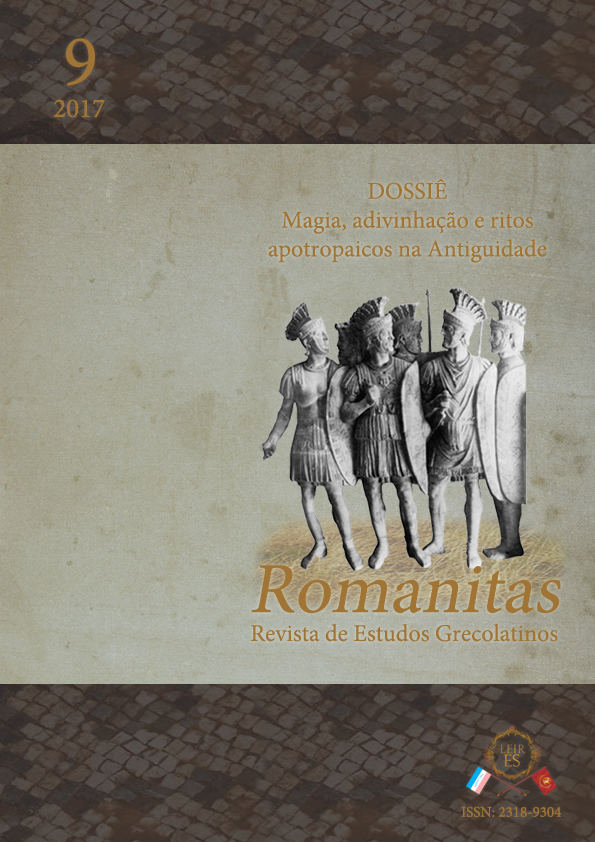Cultura escrita e comunicação oral no cristianismo antigo: as homilias como instrumentos de poder
DOI:
https://doi.org/10.17648/rom.v0i9.18488Palavras-chave:
Império Romano, Cristianismo, Cultura escrita, Comunicação oral, HomiliasResumo
Nascido em ambiente judaico, o cristianismo cedo se organizará nos termos de uma comunidade textual que tendia a atribuir à cultura escrita um papel decisivo na preservação e transmissão dos preceitos anunciados por Jesus, não sendo por acaso que a “Boa Nova”, conservada, no início, por meio da tradição oral, após algumas décadas passou a ser fixada por escrito, dentro de um amplo movimento de “burocratização” da crença. De fato, a conotação sagrada da mensagem contida nos textos cristãos, associada à formação de uma hierarquia eclesiástica cada vez mais complexa, foi determinante para a institucionalização da própria Igreja, de maneira que o cristianismo representa um notável exemplo de exercício de poder por meio do aparato da escrita. No entanto, convém salientar que a importância da escrita entre os cristãos não significou, na Antiguidade, um abandono da tradição oral, como comprovam as homilias, um gênero literário que, nos séculos IV e V, experimenta um notável desenvolvimento devido aos influxos da retórica clássica.
Downloads
Referências
Documentação textual
EUSÉBIO DE CESARÉIA. História Eclesiástica. São Paulo: Paulus, 2000.
JUSTINO DE ROMA. I e II Apologias. Diálogo com Trifão. São Paulo: Paulus, 1995.
Obras de apoio
BERARDINO, A. Dicionário patrístico e de Antigüidades Cristãs. São Paulo: Paulus, 2002.
CAMERON, A. Christianity and the rhetoric of Empire. Berkeley: University of California Press, 1994.
______. Education and literary culture. In: CAMERON, A.; GARNSEY, P. (Ed.). The Cambridge Ancient History. Cambridge: Cambridge University Press, 2008, p. 665-707. v. XIII.
CASTAGNO, A. M. Origen the scholar and pastor. In: CUNNINGHAM, M. B.; ALLEN, P. (Ed.). Preacher and audience: studies in Early Christian and Byzantine homiletics. Leiden: Brill, 1998, p. 65-87.
CAVALLO, G.; CHARTIER, R. História da leitura no mundo ocidental. São Paulo: Ática, 2002. v. 1.
CUNNINGHAM, M. B.; ALLEN, P. Introduction. In: CUNNINGHAM, M. B.; ALLEN, P. (Ed.). Preacher and audience: studies in Early Christian and Byzantine homiletics. Leiden: Brill, 1998, p. 1-20.
FLAMANT, J.; MONFRIN, F. Une culture “si ancienne et si nouvelle”. In: MAYEUR, J. M. et al. (Org.). Histoire du Christianisme: naissance d’une Chrétienté (250-430). Paris: Desclée, 1995, p. 623-673. v. 2.
GAMBLE, H. Y. Books and readers in the Early Christian Church. New Haven: Yale University Press, 1995.
HARTNEY, A. M. John Chrysostom and the transformation of the city. London: Duckworth, 2004.
HUBBEL, H. M. Chrysostom and rhetoric. Classical Philology, n. 19, p. 261-276, 1924.
KONINGS, J. A Bíblia nas suas origens e hoje. Petrópolis: Vozes, 1997.
LANE FOX, R. Cultura escrita e poder nos primórdios do cristianismo. In: BOWMAN, A. K.; WOOLF, G. (Org.). Cultura escrita e poder no Mundo Antigo. São Paulo: Ática, 1998. p. 154-182.
LIÉBAERT, J. Os padres da Igreja: séculos I-IV. São Paulo: Loyola, 2000. v. 1.
MARROU, H. I. Décadence romaine ou Antiquité Tardive? (IIIe-IVe siècle). Paris: Seuil, 1977.
______. História da Educação na Antiguidade. São Paulo: E. P. U., 1990.
MARKUS, R. A. Social and historical setting. In: YOUNG, F.; AYRES, L.; LOUTH, A. (Ed.). The Cambridge history of Christian literature. Cambridge: Cambridge University Press, 2008, p. 399-413.
MAXWELL, J. L. Christianization and communication in Late Antiquity: John Chrysostom and his congregation in Antioch. Cambridge: Cambridge University Press, 2006.
MAYER, W. John Chrysostom and his audiences: distinguishing different congregations at Antioch and Constantinople. Studia Patristica, v. XXXIII, p. 70-75, 1997.
______. John Chrysostom: extraordinary preacher, ordinary audience. In: CUNNINGHAM, M. B.; ALLEN, P. (Ed.). Preacher and audience: studies in Early Christian and Byzantine homiletics. Leiden: Brill, 1998, p. 105-137.
MORESCHINI, C.; NORELLI, E. História da literatura cristã antiga grega e latina: do Concílio de Nicéia ao início da Idade Média. São Paulo: Loyola, 2000. t. I.
NEIL, B. Towards defining a Christian culture: the Christian transformation of classical literature. In: CASIDAY, A.; NORRIS, F. W. (Ed.). The Cambridge history of Christianity: Constantine to c. 600. Cambridge: Cambridge University Press, 2008, p. 317-342.
OLIVAR, A. Reflections on problems raised by early Christian preaching. In: CUNNINGHAM, M. B.; ALLEN, P. (Ed.). Preacher and audience: studies in Early Christian and Byzantine homiletics. Leiden: Brill, 1998, p. 21-32.
QUASTEN, J. La edad de oro de la literatura patrística griega. Madrid: B.A.C., 1994.
REBOUL, O. Introdução à retórica. São Paulo: Martins Fontes, 2004.
SAXER, V. La mission: l’organisation de l’Église au IIIe. siècle. In: MAYEUR, J. M. et al. (Org.). Histoire du Christianisme: naissance d’une Chrétienté (250-430). Paris: Desclée, 1995, p. 41-75. v. 2.
SCHWARTZ, S. Imperialism and Jewish society, 200 B.C.E. to 640 C.E. Princeton: Princeton University Press, 2004.
SKARSAUNE, O.; HVALVIK, R. (Ed.). Jewish believers in Jesus: the early centuries. Peabody: Hendrickson, 2007.
STEWART-SYKES, A. Hermas the Prophet and Hippolytus the Preacher: the Roman homily and its social context. In: CUNNINGHAM, M. B.; ALLEN, P. (Ed.). Preacher and audience: studies in Early Christian and Byzantine homiletics. Leiden: Brill, 1998, p. 33-63.
WILKEN, R. L. John Chrysostom and the Jews. Eugene: Wipf & Stock, 1983.
YOUNG, F.; AYRES, L.; LOUTH, A. (Ed.). The Cambridge history of Christian literature. Cambridge: Cambridge University Press, 2008, p. 5-10; 251-258; 485-494.
Downloads
Publicado
Como Citar
Edição
Seção
Licença
Copyright (c) 2017 Romanitas - Revista de Estudos Grecolatinos

Este trabalho está licenciado sob uma licença Creative Commons Attribution-NonCommercial-NoDerivatives 4.0 International License.
a. Os autores mantêm os direitos autorais e concedem à revista o direito de primeira publicação.
b. Os autores têm autorização para assumir contratos adicionais separadamente, para distribuição não-exclusiva da versão do trabalho publicada nesta revista (ex.: publicar em repositório institucional ou como capítulo de livro), com reconhecimento de autoria e publicação inicial nesta revista.
c. Autores têm permissão e são estimulados a publicar e distribuir seu trabalho online (ex.: em repositórios institucionais ou na sua página pessoal) após a primeira publicação pela revista, com os devidos créditos.
d. Os textos da revista estão licenciados com uma Licença CC BY 4.0 Deed Atribuição 4.0 Internacional (CC BY).




























